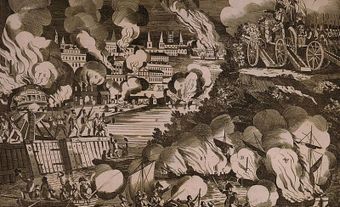Wars often have many causes. Some are long-standing problems between nations, while others are dangerous sparks that inflame attitudes and push nations to a call to arms. The Chesapeake Affair (sometimes called the Chesapeake-Leopard Affair) was a little of both. It was a symbol of the degraded relationship between Great Britain and the United States, and a spark that slowly burned to the unleashing of hostilities in the War of 1812.
During the Napoleonic Wars (1799-1815), Britain engaged in a vast naval campaign against the forces of France. The United States, however, viewed France as an old ally and a trading partner for her growing economy. While England was at war with France, US trade, including its merchant fleet, was growing, which also made British economic interests concerned. As the United States was not at war with France, trade between the two continued.
Prelude to the Chesapeake Affair
By 1807, France and Britain were conducting economic warfare to sap the other of their material strength for war. France implemented the "continental system" to deny Britain trade and resources with occupied Europe. Conversely, the British issued orders in council (1807) that forbade any of its colonies, allies, or neutral powers from trading with France. This was the beginning of the blockade of France, a controversial and successful strategy. Britain matched words with deeds, dispatching warships to key ports to enforce the decision. Britain also maintained the right to inspect any neutral ships for deserters. The US contested these decrees as illegal and unfair, and tensions between the new country and its old master began to increase.
In early 1807, the British had sent warships, enforcing their blockade, against two French vessels attempting to maintain trade with the US in Chesapeake Bay. At the time, life upon British naval vessels was nasty, hard and often unasked for; many sailors were pressed into service against their will to fill the need for manpower for the blockade. Worse, some British ships had taken to "pressing" sailors from the American vessels they inspected. As a result, desertion was a constant problem and for the men in the Royal Navy at the American station, it was no different. The temptation to escape the iron discipline and the lash was great. In the summer of 1807, a number of men deserted their British vessels to join the crew of the frigate USS Chesapeake off the coast of Virginia. Chesapeake was commanded by Commodore James Barron, a veteran sailor of the American Revolution, the Quasi War with France, and the First Barbary War.
Conflict Between USS Chesapeake and HMS Leopard
The British Vice-Admiral Sir George Berkeley ordered HMS Leopard to retrieve the deserters. Its commander, Salusbury Pryce Humphreys, issued an order for a search. Barron refused, noting that all the men had been "pressed" into British naval service. For his defiance, he received a broadside of cannon fire that injured him as well as 17 others, and killed three. While Chesapeake was a tough frigate and Barron an able commander, the ship was in some disrepair since its last major expedition and not fitted for a decisive engagement. Still, Barron mustered one fire of cannon before submitting to the inevitable. He called for surrender, but Humphreys ignored it and released his boarding party to round up the deserters in force. Each one was found, but, to complicate matters, only one of them was a British subject proper. The rest were American-born but had served in the Royal Navy, claiming to have been pressed into service.
Results of the Chesapeake Affair
Chesapeake was pulled to Halifax, and all the deserters stood trial. The British subject was executed by hanging. The American-born sailors faced a sentence of 500 lashes each, though this was commuted, and Britain attempted to redress its actions by having the men returned to the US and paying reparations. Such action was cold comfort to the American government and population, who rallied against mistreatment of its own citizenry. The Chesapeake Affair was one of the smouldering issues between the two nations that came to a head in the declaration of war in 1812.
Few ships became such a symbol of the War of 1812 as USS Chesapeake, a catalyst and victim of the political and military entanglements between Britain and the US.

 Share on Facebook
Share on Facebook Share on X
Share on X Share by Email
Share by Email Share on Google Classroom
Share on Google Classroom


